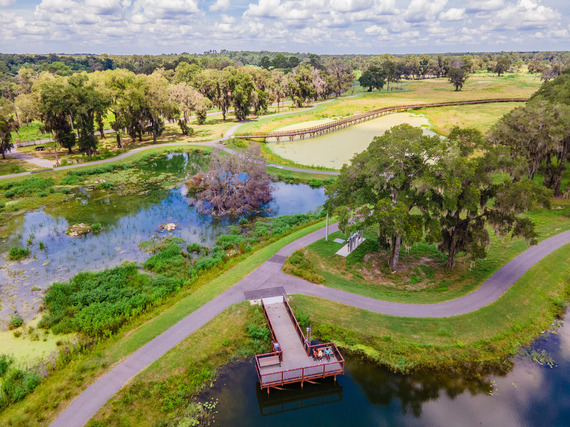 On Friday, Feb. 23, 2024, the City of Ocala held a ceremony to commemorate the addition of Ocala Wetland Recharge Park to the Great Florida Birding and Wildlife Trail, as well as the completion of the park’s new open-air pavilion. The park has 178 documented bird species, including a recent Vermillion Flycatcher. It is also home to over a dozen reptile and amphibian species and many other critters including fox squirrels, rabbits, dragonflies and more.
 Left to right: Sean Lanier, City of Ocala Engineer, Barry Mansfield, Ocala City Council President, Paul Jacobs, FWC, Peter Lee, City Manager, Ben Marciano, Ocala Mayor.
The park’s outstanding biodiversity might be considered unusual for its relatively urban location in northwest Ocala. However, this park is a well-designed wetland ecosystem, improving water quality while providing habitat for wildlife and accessible recreation for people. Paved paths, boardwalks and bridges make it easy to get up-close views of the many birds living in the impoundments. A variety of excellent educational displays around the park help visitors learn about different wildlife they may encounter and understand how the park boosts regional groundwater supplies. For those who want to learn even more, Marion Audubon offers regular bird walks for the public, including local high school and college students.
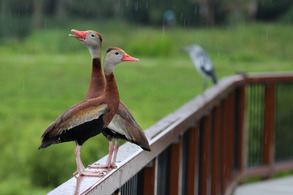
Ocala Wetland Recharge Park is one of 14 new sites that were selected to join the Trail last year after a rigorous evaluation process. New sites were chosen based on their ability to provide top-notch public access to amazing birding and wildlife viewing destinations, the ecological significance of the site, and conservation education opportunities. Learn more here.
|
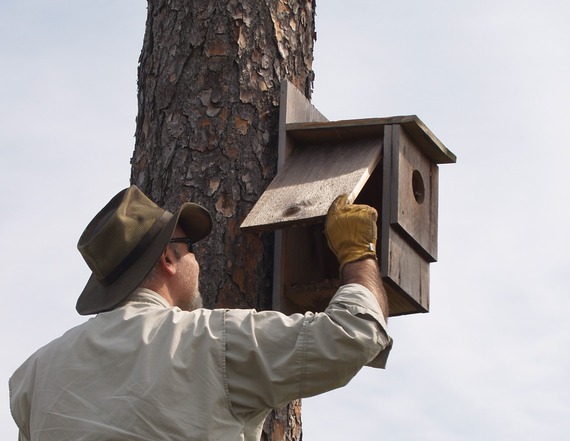 An FWC representative checking a kestrel nest box. Although kestrels aren’t backyard birds, this photo shows how a hinged door makes it easy to clean and/or check the box. Photo by FWC.
Over 20 bird species in Florida are cavity nesters, meaning they nest in tree holes and sometimes other structures such as wooden utility poles. Some species are happy to nest wherever they find a suitable cavity, while others like Carolina Chickadees and Brown-headed Nuthatches prefer to create their own.
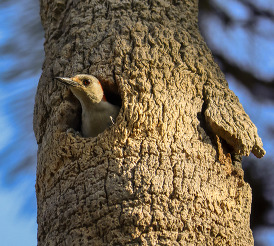
Both types of cavity nester use damaged or dead trees since the wood is both easier to excavate and more likely to come with pre-existing cavities than undamaged trees. However, the perfect tree can be hard to come by. Snags (standing dead trees) are often removed by humans, reducing suitable nesting space in areas where birds and people share space. A well-built nest box (AKA a birdhouse) can effectively mimic the role of a tree cavity and provide an alternative nesting spot for birds in need.
|
Different bird species have different needs when it comes to nest boxes. Before building or purchasing a nest box, make sure you know which species you’re trying to attract and look up which kind of box suits them. The FWC’s Planting a Refuge for Wildlife guide has information on nest boxes for 11 different species, and many more can be found through NestWatch. However, many types of nest boxes share common features that should be kept in mind.
Nest Box Guidelines:
Materials: Avoid plastic and metal since they overheat in the summer, causing harm to baby birds. Use untreated, durable wood like cypress or exterior-grade plywood. Use galvanized nails.
Roof: The front edge of the roof should extend an inch or two from the wall of the box to shield the entrance from rain.
Ventilation: Provide ventilation holes or slits just below the roof on both sides.
Floor: The floor should be slightly raised to prevent water seeping into the bottom of the nest.
Drainage: Ensure the bottom has several small drainage holes.
Cleaning: Add a hinged door or similar feature for easy cleaning and checking the box. While birds naturally tidy up their up homes, keeping the box clean will make it easier for them and encourage use of the box.
Mounting: Most bird species require nest boxes to be securely fastened to sturdy structures like posts, trees or buildings. Wrens can use hanging nests and Purple Martins can use gourds.
Perches: Cavity-nesting birds naturally perch on rough vertical surfaces, like tree bark. Avoid adding horizontal perches to your bird box as they attract unwanted guests like House Sparrows, Starlings or even predators. Instead, you can roughen the surface below the entrance to make it more like a natural cavity.
Protection from Predators: For nest boxes installed on poles, use a baffle to keep predators from climbing up to the nest.
Style and Size: Make sure you build or purchase your nest box using dimensions and specifications appropriate for the types of bird you are trying to attract. The entrance size is particularly important.
Timing: Late February to June is prime nesting season, making it the best time to install your nestbox. However, boxes can be installed any time of year.
Learn more with this helpful infographic.
 FWC representatives building Wood Duck nest boxes.
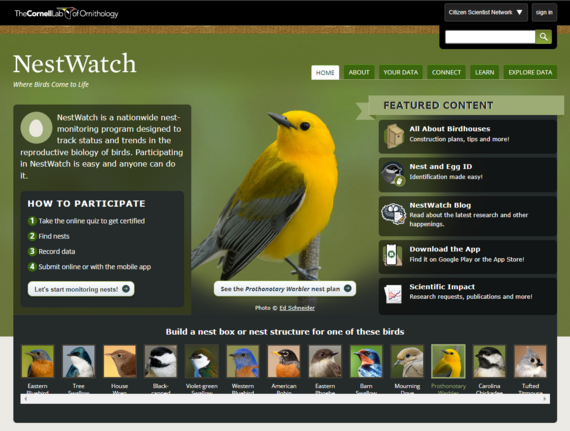 A screenshot of the NestWatch webpage, featuring a Prothonotary Warbler.
Developed by the Cornell Lab of Ornithology, NestWatch is a nationwide nest-monitoring project. Citizen science volunteers track nearby nests, gathering data on when nesting happens, how many eggs laid are laid, hatch rates, and hatchling survival. Scientists use the data to track the status and trends of bird reproductive biology. NestWatch data is a wonderful resource for bird management and conservation.
Anyone can participate with four simple steps:
-
Take the online quiz to get certified
- Find nests
- Record data
- Submit online or with the mobile app
Try it out!
|